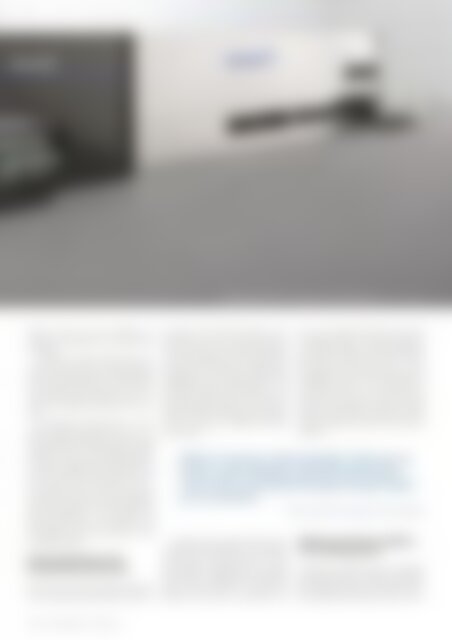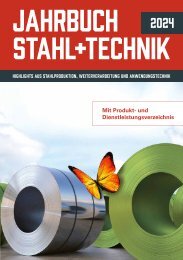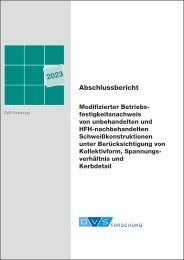STEEL + TECHNOLOGY 04/2019 EXTRACT
STEEL + TECHNOLOGY 04/2019 EXTRACT
STEEL + TECHNOLOGY 04/2019 EXTRACT
You also want an ePaper? Increase the reach of your titles
YUMPU automatically turns print PDFs into web optimized ePapers that Google loves.
<strong>STEEL</strong> PROCESSING | 79<br />
Rendering scheme of a complete laser blanking line (Picture: Schuler)<br />
blanks which are also spotless—an<br />
important requirement for critical body<br />
shell parts.<br />
In 2014, one high-end German automaker<br />
ordered its first two laser blanking<br />
lines for mass production, and the equipment<br />
began producing two years later.<br />
The same German carmaker went on to<br />
order two additional high-tech lines in<br />
2017.<br />
At roughly the same point in time,<br />
Schuler began development work on a<br />
new concept featuring two laser heads<br />
instead of three. “We needed a ‘breadand-butter’<br />
machine that would also deliver<br />
solid, acceptable performance for the<br />
rest of the world,” says Liebel. The decision<br />
proved to be the right one, as evidenced<br />
by the orders for two Laser Blanking<br />
Lines this year, from China and South<br />
Africa respectively. “The systems are<br />
becoming more and more dynamic, and<br />
the concept will win out in the end,” says<br />
a confident Liebel.<br />
Advanced distance control<br />
between laser head and coil<br />
One of the things that makes these systems<br />
so dynamic is the distance control for<br />
the lasers. This control maintains a distance<br />
of 0.7 to 0.9 mm from the continuously<br />
moving coil and, where necessary,<br />
corrects the distance within fractions of a<br />
second to ensure that any residual surface<br />
irregularities in the sheet metal do not<br />
damage the heads. Liebel explains: “This<br />
axis is critical to the line’s output. Each coil<br />
contains residual waves. If I’m looking to<br />
blank at a rate of 100 meters per minute, I<br />
need to be able to respond extremely<br />
dynamically.”<br />
Larger surface irregularities are eliminated<br />
by the straightener. “The straightening<br />
result is a key ingredient to a stable<br />
process, especially for the laser<br />
blanking line,” adds Regional Sales Manager<br />
Justine Fonteyne. “To make this<br />
happen, we use the ‘Check2Flat’ system,<br />
which adjusts the crowning on the<br />
straightener rollers.” Either the visualization<br />
system makes a recommendation<br />
based on the adjustment system, which<br />
the operator must then review, or the<br />
straightener itself can even provide fully<br />
automated control. “It’s important to<br />
remove as much of the tension from the<br />
material as possible so that the metal<br />
doesn’t pop up during blanking. These<br />
types of systems help to ensure process<br />
stability.”<br />
When it comes to yield strengths, there are no<br />
limits in laser blanking. We have performed<br />
many tests, and advanced high-strength steels<br />
are no problem.<br />
Martin Liebel, site manager Schuler Heßdorf<br />
Adapting production capabilities<br />
across stamping plants<br />
According to Liebel, another increasingly<br />
important aspect for carmakers is the intelligent<br />
capacity utilization of production facilities<br />
spread across the globe. “But it’s diffi-<br />
<strong>STEEL</strong> + <strong>TECHNOLOGY</strong> 1 (<strong>2019</strong>) No. 4


















